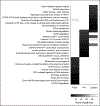Cardiopulmonary Phenotypes and Protein Signatures in Children With Down Syndrome
- PMID: 37306037
- PMCID: PMC11060669
- DOI: 10.1177/00099228231179453
Cardiopulmonary Phenotypes and Protein Signatures in Children With Down Syndrome
Abstract
Pulmonary disease, lower respiratory tract infection, and pneumonia are the largest causes of morbidity and mortality in individuals with Down syndrome (DS), but whether pulmonary diagnoses in children with DS are common and occur independently of cardiac disease and pulmonary hypertension (PH) is unknown. Cardiopulmonary phenotypes were examined in a cohort of 1248 children with DS. Aptamer-based proteomic analysis of blood was performed in a subset (n = 120) of these children. By the age of 10 years, half of the patients in this cohort (n = 634, 50.8%) had co-occurring pulmonary diagnoses. That proteins and related pathways were distinct between children with pulmonary diagnoses and those with cardiac disease and/or PH may indicate that pulmonary diagnoses appear to occur independently of cardiac disease and PH. Heparin sulfate-glycosaminoglycandegradation, nicotinate metabolism, and elastic fiber formation were ranked highest in the group with pulmonary diagnoses.
Keywords: Down syndrome; dysphagia; pneumonia; pulmonary hypertension; trisomy 21.
Conflict of interest statement
Declaration of Conflicting InterestsThe author(s) declared the following potential conflicts of interest with respect to the research, authorship, and/or publication of this article: Drs Deterding and DeBoer are founders and consultants for EvoEndoscopy and have patents in endoscopy procedures related to the company. Drs DeBoer and Deterding are consultants for Boehringer Ingelheim. Dr. DeBoer has received grant funding from the Cystic Fibrosis Foundation and NIH. Dr Deterding is founder and CEO of Now Vitals, Inc. and founder and Chief Medical Officer of Earables, Inc. The authors declare that they have no other conflict of interest.
Figures


References
-
- Freeman SB, Taft LF, Dooley KJ, et al. Population-based study of congenital heart defects in Down syndrome. Am J Med Genet. 1998;80:213–217. - PubMed
-
- Bittles AH, Bower C, Hussain R, Glasson EJ. The four ages of Down syndrome. Eur J Public Health. 2007;17(2):221–225. - PubMed
-
- Evans JM, Dharmar M, Meierhenry E, Marcin JP, Raff GW. Association between Down syndrome and in-hospital death among children undergoing surgery for congenital heart disease: a US population-based study. Circ Cardiovasc Qual Outcomes. 2014;7(3):445–452. - PubMed
-
- Yang Q, Rasmussen SA, Friedman JM. Mortality associated with Down’s syndrome in the USA from 1983 to 1997: a population-based study. Lancet. 2002;359:1019–1025. - PubMed
MeSH terms
Grants and funding
LinkOut - more resources
Full Text Sources
Medical

